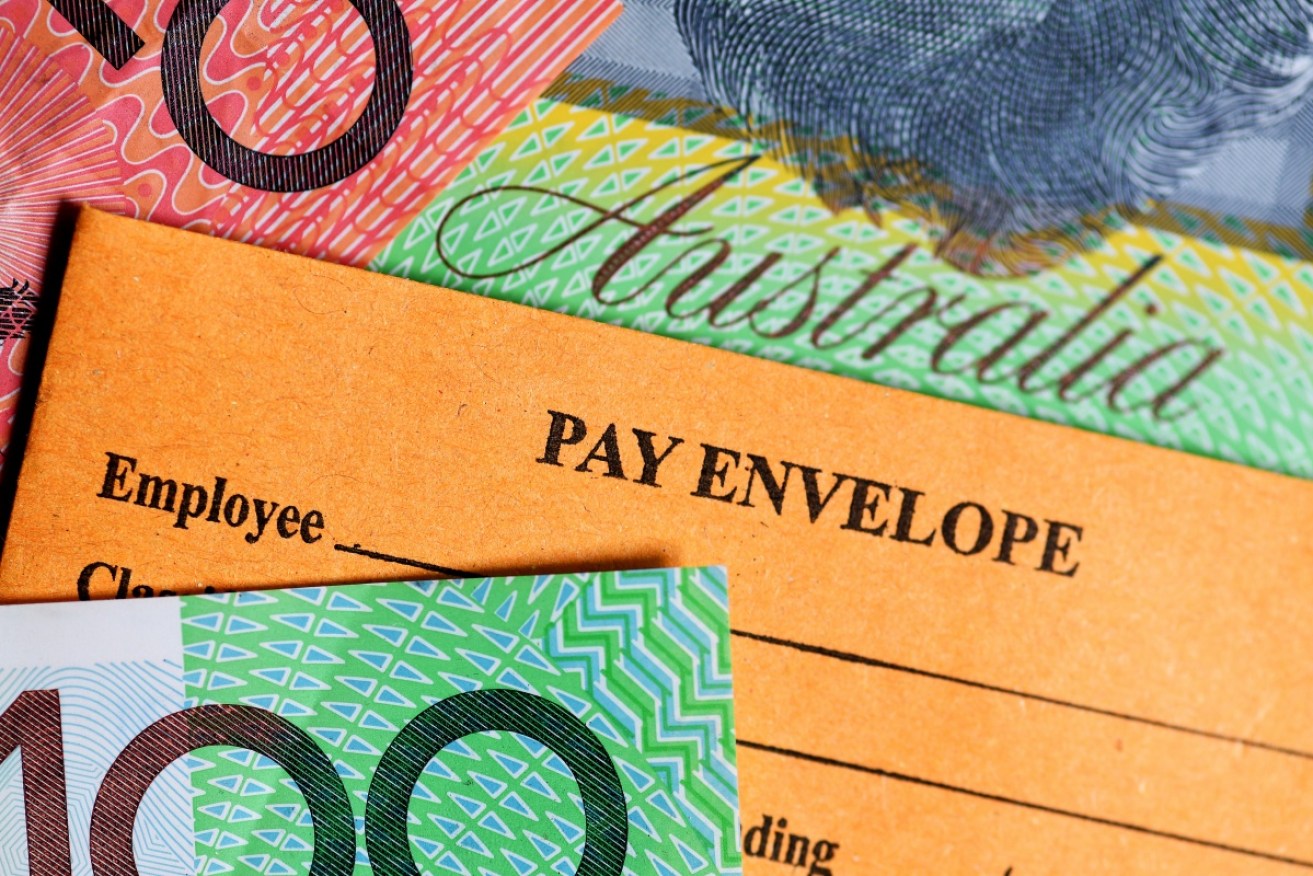At long last the countdown for wages growth begins – maybe


Total hourly rates of pay, excluding bonuses, rose by a seasonally adjusted 2.2 per cent year-on-year, the Australian Bureau of Statistics says. Photo: AAP
Wednesday, November 14, 11.30 am – people who keep watch on where our economy is going are counting down to that deadline for an important reading on our key domestic challenge and uncertainty: when wages growth might finally climb off the floor.
There’s actually been an outbreak of optimism about that reading. Recent experience suggests people should not get too excited.
A third of the 22 economists polled by Bloomberg are forecasting the Australian Bureau of Statistics September quarter wage price index will be up 0.7 per cent on the June quarter.
That would be the strongest such growth in four-and-a-half years and a cause for genuine celebration. Nearly all the other economists are predicting still-respectable 0.6 per cent growth.
Decent wages growth is the missing ingredient in the Australian economic pie.
Without it, strong consumption can’t be sustained, inflation won’t rise into the Reserve Bank’s target ban, households find it hard to make a dent in their debt levels, the federal budget stops adding up down the track as it’s relying on hefty 3.5 per cent wages growth, and a significant proportion of the population will feel more miserable and disenfranchised as they fail to “get ahead”.
Having a go won’t be enough to get one.
One quarter does not a wages summer make, but the forecasters think a combination of July’s 3.5 per cent minimum wage increase, some key new enterprise bargaining agreements (EBAs) coming into force, and falling unemployment and underemployment will deliver pay packet magic.
Problem is, they’ve thought that before. The September quarter index last year included a 3.3 per cent minimum wage rise and it made little difference – the index rose 0.5 per cent, leaving annual growth hovering around the 2 per cent level, where it’s been stuck for the past few years.
Forecasters were getting optimistic this time last year, thinking wages were about to turn the corner and start rising again. That corner has been a year away all decade.
One of the RBA’s many admirable qualities is its willingness to put up its hand and admit when it gets things wrong (something rather rare among private sector forecasters who are at least as imperfect as our central bank).
The accompanying RBA graph tells the story wage growth “surprises” all decade.
And our central bankers are still doing it. The RBA’s quarterly statement on monetary policy on Friday: “The decline in the unemployment rate is also expected to flow through to slightly higher wages growth than previously forecast. In addition, growth in the wage price index in the June quarter was slightly stronger than had been expected in the August Statement. Wages growth is expected to be boosted a little in the September quarter as a result of the 3.5 per cent increase in award and minimum wages from 1 July.”
But, perhaps having learned from experience, the bank is not getting carried away just yet: “Further out, the pick up in wages growth is still expected to be gradual, consistent with information from the bank’s liaison program and the expectation of a steady decline in labour market spare capacity. Wage outcomes from enterprise bargaining agreements are likely to remain a drag on overall wages growth, despite picking up recently.”
The RBA and Treasury drink from much the same forecasting trough, but Scott Morrison’s budget figures are based on greater optimism, predicting 2.75 per cent growth this financial year, 3.25 per cent the next and 3.5 per cent thereafter.
The decade of optimistic forecasts (anyone remember then-federal Employment Minister Eric Abetz fretting about a “wages explosion” in 2014?) have repeatedly come to grief where simplistic economic text book cyclical guidance has collided with complex structural reality.
The loss of workers’ bargaining power, casualisation, increased foreign and domestic competition, technological productivity changes, job insecurity and something very much like a corporate remuneration strike are combining to suppress workers’ share of national income.
Much closer to reality than textbooks is the latest NAB business conditions survey.
The NAB economists ask and answer their own question: “What does the survey suggest about inflation and wages? Both purchase costs and final products prices (including retail prices) edged up in the month, while labour costs (a wage bill measure) ticked down. The building price pressures evident in these survey measures through mid-2018 appear to have abated over the past two months. Overall, while the survey suggests ongoing employment growth, labour costs growth remains relatively contained and with weak conditions in retail at present, consumer price rises are likely to remain meek.”
Not so optimistic – the real world is indeed a complex place.
There’s an element of the chicken and the egg about the RBA’s continuous relative optimism on wages – it’s also maintains optimism about inflation getting back into its two-to-three per cent target zone. It needs wages growth to get there.
The inflation optimism was present again in Friday’s SoMP with the RBA revising up its headline inflation forecast to be within the zone late next year – at which stage we could expect the bank to be moving towards its first interest rate rise since 2010.
I have a sneaking suspicion that the RBA is leaning towards what it wants to see and is perhaps trying to talk up expectations. If people think inflation is rising, they are more likely to seek price and wages rises that will make it rise.
Quite simply, the SoMP doesn’t come up with much evidence to back up the revision.
Instead, it dismisses that its two underlying measures have been going backwards.
The “weighted median” measure has dropped in the past two quarters from 2.1 per cent (12 months ended) to 1.7 per cent. A year ago the figure was 2.2 per cent – underlying inflation on this measure has fallen by 0.5 of a percentage point, which is not trivial. It has been one-way traffic and the rate of decline is getting faster.
The figures are not as dramatic on the “trimmed mean” in year-ended terms. It is currently 1.8 per cent and has been 1.8 or 1.9 per cent in each of the past five quarters. It is still stuck below the target range but not heading south. However, the past three quarterly figures have been 0.6, 0.5 and 0.4. Yes, that’s falling.
Neither measure fits with the story that inflation is slowly gaining momentum and, any day now, will be back in Goldilocks territory.
That’s part of what makes 11.30am on Wednesday so important. If the optimists are wrong, if the quarterly wage price index again comes in at 0.5 per cent or lower, it will be back to the drawing board for policy expectations.
I hope my caution is unwarranted. I hope the optimists are right. But I’ve been disappointed too many times to bother putting any (metaphorical) champagne on ice.










